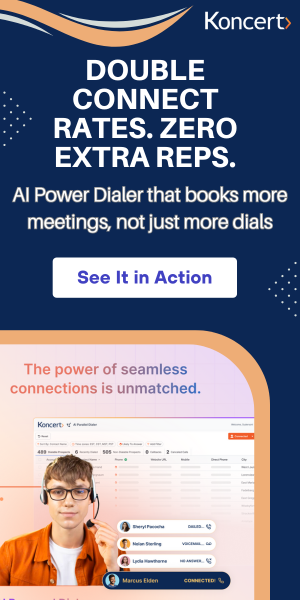A predictive dialer is an advanced outbound calling system used primarily in call centers and sales environments to maximize the talk time of agents and increase overall calling efficiency. It achieves this by using sophisticated algorithms to predict when an agent will become available for the next call and then automatically dials multiple phone numbers simultaneously, often more numbers than there are agents available.
Here's a deeper dive:
How a Predictive Dialer Works
Algorithm-Driven Dialing: The core of a predictive dialer is its algorithm. This algorithm continuously analyzes various real-time metrics, including:
-
Average Handle Time (AHT): The average time agents spend on calls.
-
Call Connection Rates: The percentage of dialed calls that result in a live person answering.
-
Agent Availability: How many agents are currently idle or about to become idle.
-
Abandoned Call Rate: The percentage of calls that connect but no agent is available (which regulations limit).
-
Time of Day/Day of Week: Historical data on when prospects are most likely to answer.
Simultaneous Dialing: Based on these predictions, the dialer calls multiple numbers from a predefined list at once. For example, if it predicts an agent will be free in 10 seconds and that only 30% of calls are answered, it might dial 3-5 numbers to ensure one connects just as the agent finishes their previous call.
Filtering and Routing:
-
It filters out unproductive calls like busy signals, disconnected numbers, and fax machines.
-
Many predictive dialers also have answering machine detection (AMD) to identify voicemails. If a voicemail is detected, it can either hang up or automatically "drop" a pre-recorded message without using agent time.
-
When a live person answers, the dialer immediately routes that connected call to the next available agent.
Minimizing Idle Time: The goal is to ensure that agents are constantly engaged in conversations, virtually eliminating the time they would spend manually dialing, waiting for rings, or dealing with non-answers.
Key Benefits of AI Predictive Dialers:
-
Massive Increase in Agent Productivity: This is the primary benefit. By automating dialing and filtering out unproductive calls, agents spend significantly more time talking to live prospects, potentially tripling or quadrupling their talk time compared to manual dialing.
-
Higher Call Volumes: Enables a single agent or team to make a much larger number of outreach attempts in a given period.
-
Reduced Operational Costs: Maximizing agent efficiency means you can achieve more with the same or fewer agents, leading to cost savings.
-
Improved Contact Rates: By intelligently dialing based on optimal times and filtering non-answers, the system increases the probability of reaching live contacts.
-
Data-Driven Optimization: The underlying algorithms learn and adapt over time, continuously refining dialing strategies based on real-time campaign performance.
-
Scalability: Easily scales up or down to handle varying call volumes and team sizes.
-
Integration with CRM: Most predictive dialers integrate with CRM systems, allowing agents to see relevant customer information as soon as a call connects and automatically log call details.
Common Use Cases of AI Predictive Dialers:
-
Telemarketing: High-volume outbound campaigns for sales.
-
Collections: Reaching out to customers for overdue payments.
-
Lead Generation/Qualification: Quickly moving through large lead lists.
-
Market Research & Surveys: Conducting large-scale phone surveys.
-
Customer Service Outreach: Proactive customer engagement (e.g., appointment reminders, follow-ups).
Challenges of Predictive Dialer
Call Abandonment: This is the most significant challenge. Because the dialer calls more numbers than available agents, there's a risk that a call will be answered when no agent is immediately free. This leads to "dead air" or a "silent call" before the system hangs up. High abandonment rates are frustrating for prospects and can lead to:
-
Negative customer experience.
-
Reputational damage.
-
Legal and Compliance Issues: Many countries and regions (e.g., FCC in the US, Ofcom in the UK) have strict regulations limiting the maximum permissible abandoned call rate. Violations can result in significant fines.
Compliance Complexity: Beyond abandonment rates, predictive dialers must adhere to various telemarketing laws, including Do Not Call (DNC) lists, call time restrictions (e.g., not calling too early or too late), and consent requirements (e.g., TCPA in the US).
Less Personalization: Because agents are immediately connected to a live person, they have less time to review prospect information before the conversation starts compared to other dialer types (like preview dialers). This can make highly personalized outreach challenging.
Agent Burnout: The continuous, high-intensity nature of back-to-back calls can be mentally taxing for agents, potentially leading to stress and burnout if not managed with proper breaks and support.
Technical Sophistication: Setting up and fine-tuning a predictive dialer requires a good understanding of its settings and algorithms to optimize performance and maintain compliance.
Data Quality Dependency: The effectiveness of the dialer relies heavily on clean, accurate, and regularly updated contact lists. Poor data will lead to wasted dials and lower efficiency.
In summary, a predictive dialer is a powerful tool for high-volume outbound calling, designed to maximize agent talk time. However, its effectiveness is balanced by the critical need to manage call abandonment rates and ensure strict regulatory compliance
Related Posts
10 min read
High-Quality Outreach - Why Koncert's ZigZag Dialing® Replaces Call Blasting
Dec 12, 2025 by Koncert Marketing
13 min read
7 Outbound Sales Trends for 2026 - AI, Latency, & Max Connect
Dec 4, 2025 by Koncert Marketing




